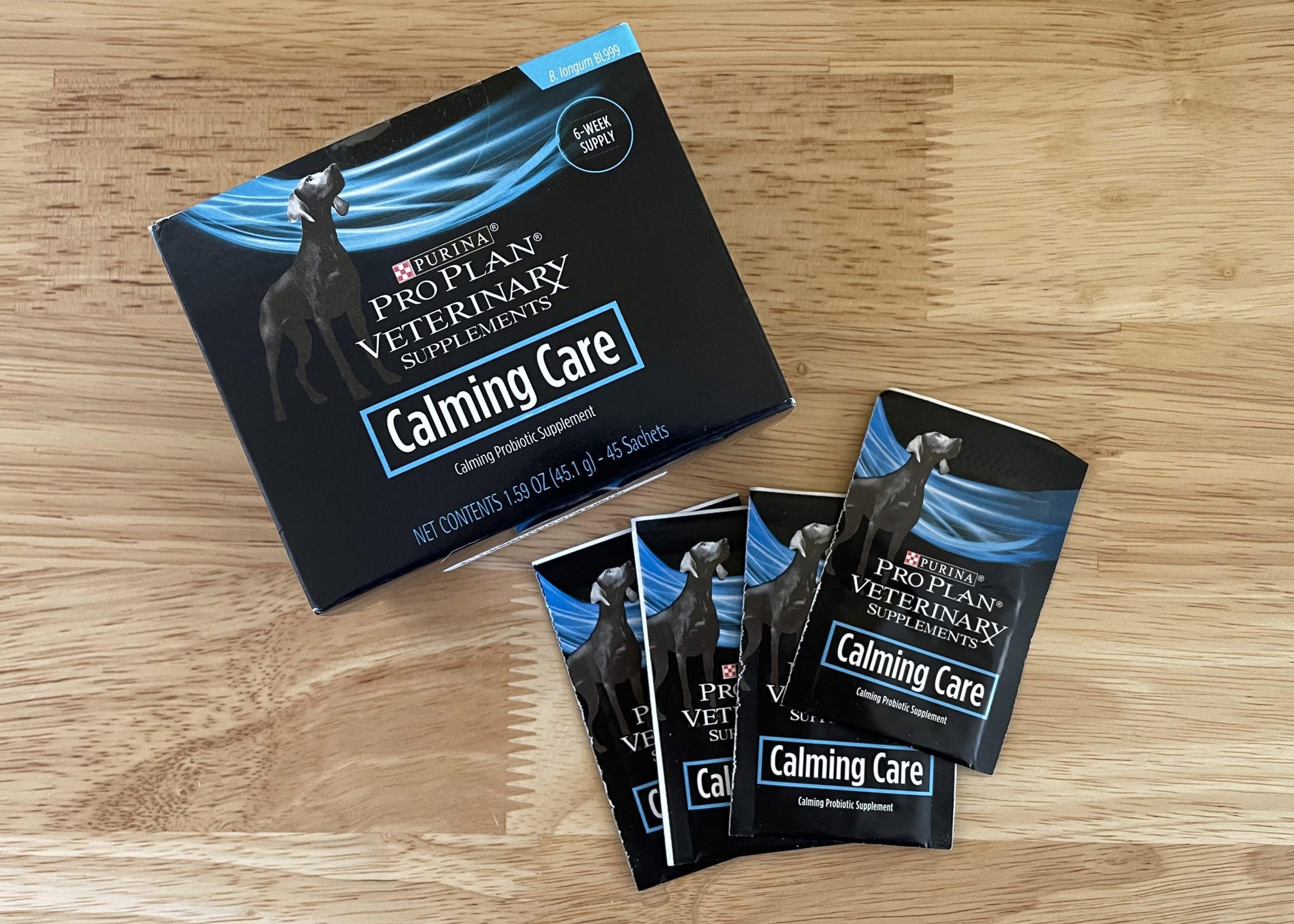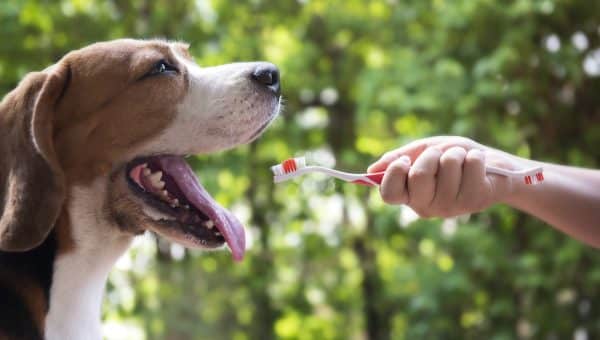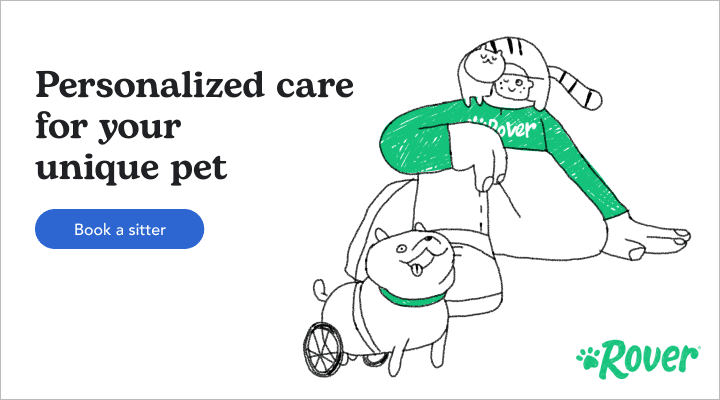- This post contains affiliate links. Read more here.
- Not a substitute for professional veterinary help.
Just like people, our pets can develop anxiety—that nagging fear of real or imagined danger that leaves them (and us) feeling unsettled and agitated. As you may have experienced yourself, there is almost nothing worse than feeling helpless to stop an anxiety spiral, no matter which side of it you’re on.
More and more pet parents are looking for solutions for their pets’ anxiety, and their search has led to the rise of a wide range of new calming products for pups, from beds and heartbeat toys to medications. Among these new products are “calming treats” for dogs. But do calming treats work to manage dog anxiety, and, if so, how?
We consulted Dr. Rebecca Greenstein, Veterinary Medical Advisor for Rover and Chief Veterinarian at Kleinburg Veterinary Hospital, and Dr. Erin Perotti-Orcutt, DVM at Four Paws Veterinary Center, to find out if these treats are worth it for your dog.
How Do Calming Treats Work for Dog Anxiety?
Anxiety is a natural response to fear and discomfort. The fight, flight, or freeze reaction is a healthy and necessary survival tool in both humans and dogs. It evolved to be activated in response to real threats. However, when this reaction occurs in anticipation of something that can’t (or isn’t likely to) do actual harm, or when it happens regularly, it can be extremely distressing to both dogs and pet parents.
Calming treats, sometimes called calming chews or calming bites, are dietary supplements intended to reduce the impact of your dog’s fight, flight, or freeze response. While they all have the same goal of soothing your pet’s stress, different types of treats target different parts of your dog’s system.
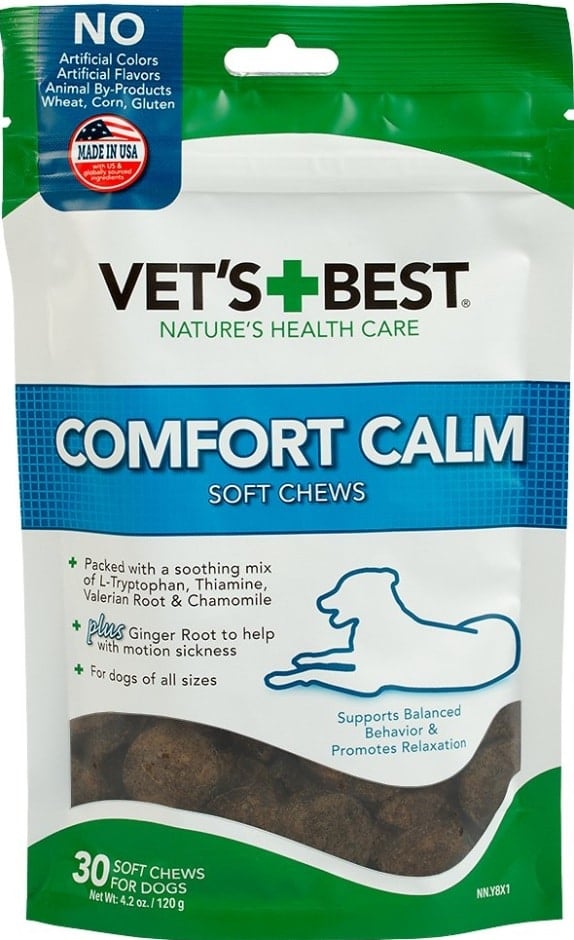
Vet’s Best calming treats have tryptophan, the drowsy ingredient in turkey.
Some calming chews make use of calming ingredients like casein, tryptophan, or melatonin. Casein is a milk protein that has been proven to offer calming effects to dogs, and tryptophan is the thing in turkey that makes you sleepy after Thanksgiving dinner. Melatonin is a natural hormone that typically helps to regulate sleep; extra melatonin can trick a dog’s body and mind into settling down for rest.
Vet’s Best Calming Soft Chews are a good example of this kind of chew. Their leading ingredient is L-Tryptophan, and they’re designed to be given once per day for general maintenance or 30 minutes before an especially stressful situation.
Other calming treats specifically target the brain and other systems that impact dogs’ emotional response. Some rely on amino acids like L-Theanine, which are thought to increase a dog’s serotonin and dopamine levels (key neurotransmitters and hormones that help to control mood). Zesty Paws Calming Bites is a good example.
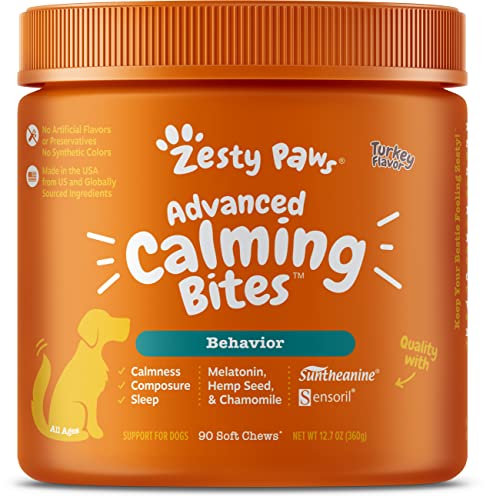
Zesty Paws Calming Bites contain a lot of the most popular calming ingredients, including L-Theanine.
Calming treats with CBD, a substance derived from hemp, target the body’s endocannabinoid receptors. The endocannabinoid system plays a regulatory role in both dogs and humans, aiding in sleep, emotional processing, and a variety of other functions. Austin and Kat Bailey’s No More Wiggles Chews are a popular pick.
Then there are probiotics, which target the gut and support digestive health. They frequently appear in calming treats to help dogs who develop diarrhea or stomach trouble as a result of their stress.
But probiotics may do more than manage symptoms. Some studies have suggested that a healthier, better-regulated gut can also positively impact a dog’s mental state. Instead of being offered as-needed, these treats work best when they’re fed regularly to slowly improve digestive health over time.
Purina ProPlan Calming Care is a good example of a probiotic calming aid. It comes in powder form and goes on top of a dog’s daily meals. It’s meant to work over time, which is why each box of the supplement contains six weeks’ worth of individually-packaged doses. We’ve tried it on our own anxious pups.
Do Dog Calming Treats Really Work? Experts Answer
Because of the wide body of anecdotal evidence, calming treats seem promising. But what do the experts say? Do dog calming treats really work?
Dr. Greenstein and Dr. Perotti-Orcutt both say yes, calming treats are helpful for many dogs—but not all calming treats are created equal.
How To Tell Good Calming Treats from Bad Ones
Because calming treats are classified as nutritional supplements (also known as nutraceuticals), not medications (aka pharmaceuticals), they’re much more loosely regulated.
On one hand, this makes them more accessible; you don’t need a prescription for calming treats. But it also means that treats can be marketed as “calming” without much evidence.
Dr. Perotti-Orcutt says reading the fine print on a calming product is especially important. “There are certainly some good ones, but there isn’t much regulation around nutraceutical products, so [manufacturers] can make a lot of unfounded claims,” she says.
For example, chamomile is a common ingredient in calming treats, including those listed above. Chamomile sounds nice to humans, but a dog wouldn’t eat chamomile in the wild. Dr. Perotti-Orcutt points out that while there’s no indication the herb would be harmful to your pet, there’s also not much evidence yet to suggest chamomile would have the same soothing effect on a dog’s system as it would on a human’s.
Calming ingredients that have been tested and shown to be effective on dogs include casein, tryptophan, melatonin, and L-theanine (also known as Suntheanine).

Capuski via iStock
A Multi-Pronged Approach to Managing Dog Anxiety
Dr. Greenstein and Dr. Perotti-Orcutt both also note that calming treats are most effective when they’re part of a larger anxiety management strategy.
As Dr. Greenstein points out, “There is a growing amount of research that shows that calming treats can help in decreasing anxiety. But not every patient, every dog, will be as easily managed with something as simple as a treat and nothing else.”
The best and most effective approach will always be one that takes into account the source of the anxiety—which is ultimately just a symptom, not a cause.
“The question is ‘What seems to be triggering the anxiety?'” says Dr. Greenstein. “Successful management depends on us tailoring the treatment, specifically, to an individual patient. So, what’s causing anxiety for one dog, and how to treat it, might be very different than for another dog.”
It’s also important to consider a multi-faceted approach to anxiety management. “More serious cases might need pharmaceuticals as well as behavioral therapy,” explains Dr. Greenstein. “The bottom line is [calming] treats are helpful, but you don’t want owners to over-rely on them. In patients who have severe anxiety, it’s not enough.”
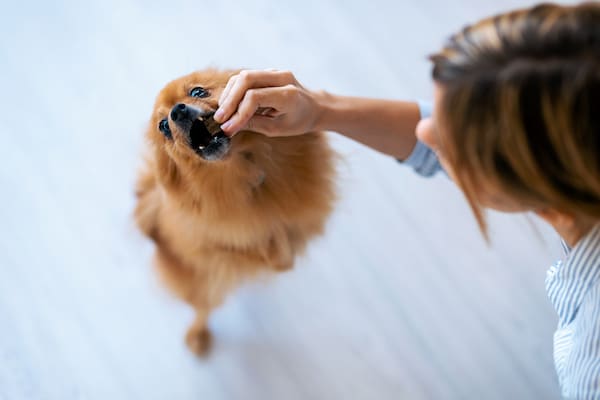
nensuria via iStock
Dr. Perotti-Orcutt is in agreement, noting that while calming treats should “definitely [be] in the toolbox,” a multimodal approach that also includes pheromones, pressure wraps, and puzzle toys is the optimal way to go for home remedies.
Dr. Greenstein adds crate training to help with separation anxiety, plenty of exercise for physical and mental stress relief, and encouraging your dog’s independence, such as having them play with a toy on their own in a separate room.
Bottom Line: The Pros and Cons of Calming Treats for Dogs
Experts agree: an appropriate, high-quality calming supplement can help manage a dog’s anxiety, especially if it contains proven calming ingredients like casein, tryptophan, melatonin, and L-Theanine. They’re most effective as part of a larger anxiety management toolkit.
But while calming treats work for many pets, they aren’t a one-size-fits-all solution. Some dogs need more help, and it takes experimentation to find the right combination of tools to help an anxious pup.
Dogs typically get the most out of calming treats when:
- Their anxiety triggers are specific and predictable (like thunderstorms, fireworks, or your regular departure from the house).
- Calming treats are used in tandem with behavioral methods and solutions like training, Thundershirts, and puzzle toys.
Pets may require alternative methods to reduce their anxiety when:
- They’re picky eaters and won’t touch the treats.
- Their anxiety is extreme or manifesting in troublesome ways like aggression, beyond the limits of a supplement to manage.
- The cause of the anxiety is complex or unpredictable.
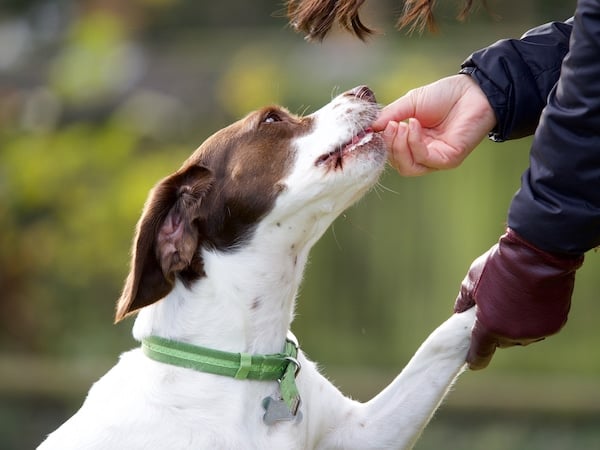
andrewginns via iStock
If you’re ready to try calming treats or supplements, it’s a good idea to loop your vet in to your plan. Your vet can make strategic recommendations and also flag any ingredients that might not be a good choice for your particular pup. Armed with good advice and the right tools, many dogs see a dramatic decrease in their anxiety levels—and their humans’ too.
How We Chose
The products featured here were selected based on a combination of our hands-on testing, a comprehensive look at customer reviews, and the input of our veterinary experts. For the supplements included, we prioritized quality ingredients and our first-hand experiences—there’s no better measure to how well a product works than seeing how our much-loved pets respond (or, in this case, relax).

